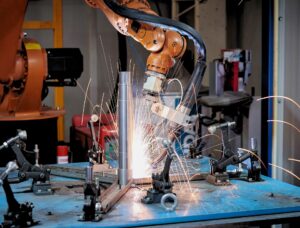When it comes to fabrication, aluminum and steel are two of the most commonly welded metals—but they couldn’t be more different in how they behave under heat. Whether you’re a welder, fabricator, or engineer, understanding the key differences in welding aluminum vs. steel is critical for achieving clean, strong, and distortion-free welds. In this guide, we’ll compare the welding processes of aluminum and steel, focusing on pre-weld preparation, thermal conductivity, and filler material requirements—and how welding cameras and visual inspection techniques can enhance precision for both.
1. Pre-Weld Preparation: Surface Cleanliness Is Key
Aluminum
Aluminum forms a tenacious oxide layer that melts at a much higher temperature than the base metal (approx. 3x higher). If not removed, this oxide can prevent fusion and create weld defects like lack of fusion or porosity.
What to do:
- Remove oxide using a stainless steel wire brush or chemical etching
- Clean with acetone to eliminate oil and moisture
- Perform just-in-time cleaning to avoid reoxidation
- Use TIG welding (Tungsten Inert Gas) for better control and cleanliness
Steel
Steel surfaces often have mill scale, rust, or oil but are generally easier to clean.
What to do:
- Remove contaminants using grinders or solvents
- For carbon steels, preheat thicker sections to reduce cracking
- Metal arc welding processes like MIG welding or stick welding are more forgiving
Tip: A welding camera helps confirm surface prep quality and verifies arc stability during the first weld passes.
2. Thermal Conductivity: Heat Input Control Matters
Aluminum
Aluminum conducts heat rapidly, which means:
- Heat dissipates quickly, requiring higher amperage
- There’s a higher risk of burn-through, especially on thin material
- Precise heat control and travel speed are essential
Use weld monitoring systems to track arc behavior and heat distribution in real time. This is especially useful in MIG and TIG welding applications for aluminum, such as in automotive or aerospace fabrication.
Steel
Steel retains heat better, reducing the risk of burn-through but increasing the risk of:
- Residual stresses
- Distortion or cracking due to uneven expansion/contraction
Solution:
- Control interpass temperature
- Use arc welding cameras to optimize travel speed and monitor bead consistency
3. Filler Material: Choose the Right Alloy Match
Aluminum
Filler selection depends on both the base alloy and performance needs (corrosion, strength, ductility). Common choices include ER4043 and ER5356.
Challenges:
- Some alloys are non-weldable
- Risk of hot cracking without proper filler match
- Laser welding and pulsed MIG are often used for difficult alloys
Welding camera manufacturers now offer real-time arc image systems to detect filler feeding inconsistencies in robotic aluminum welding.
Steel
Steel welding offers broader filler options, including:
- ER70S-6 for mild steel in MIG welding
- E7018 for shielded metal arc welding (SMAW)
- Dual-shield wires for higher deposition in structural jobs
Welding technology advancements like dual-camera systems now help monitor wire feed speed and arc stability in robotic welding operations for steel.
Welding Aluminum vs Steel Key Differences Summary
| Feature | Aluminum | Steel |
| Oxide Layer | Requires aggressive removal | Easier to clean |
| Thermal Conductivity | High (requires more heat) | Lower (easier to manage) |
| Melting Point | ~660°C (lower) | ~1,370°C (higher) |
| Filler Material | Alloy-specific, risk of hot cracking | More forgiving, widely available |
| Welding Processes | TIG, MIG, pulsed MIG, laser | MIG, Stick, Flux-core, TIG |
| Weld Monitoring | Essential for heat control | Useful for distortion and slag issues |
How Welding Cameras Help Both Aluminum and Steel Applications
✅ Visual Feedback: High-speed arc welding image systems help detect porosity, undercut, and poor fusion instantly
✅ Process Control: Monitor travel speed, wire feed, and arc stability in both manual and robotic welding setups
✅ Confined Space Monitoring: Essential in remote or hard-to-reach areas, especially in shipbuilding and heavy steel structures
✅ Real-Time Inspection: Integrate with welding inspection techniques to reduce rework and ensure traceability
Conclusion: Know Your Metal, Use the Right Tools
Welding aluminum and steel each come with their own set of challenges—but with the right welding techniques, filler metals, and weld monitoring cameras, you can consistently achieve strong, defect-free joints.
Whether you’re fabricating aircraft parts with TIG welding, building automotive panels with MIG welding, or managing structural steel welds, Mecaweld’s camera for welding systems can help you visualize every detail and optimize for quality.
Need help choosing a welding camera for your application? Contact Mecaweld today to explore custom solutions for both aluminum and steel welding processes.



